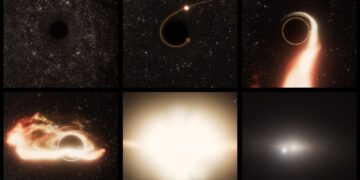Every now and then, the universe serves up a mystery so thrilling, it redefines what we thought we knew about the cosmos. That’s exactly what happened when astronomers witnessed a massive flare of light from deep space—signaling something extraordinary. Using NASA’s Hubble Space Telescope, scientists discovered a supermassive black hole doing the unthinkable: it was roaming the outskirts of its galaxy, far from the central core, feasting on a helpless star.
What Is a Tidal Disruption Event? Not Just Another Cosmic Flash
A Tidal Disruption Event (TDE) is one of the most violent and fascinating celestial occurrences. It’s what happens when a star gets too close to a black hole—and doesn’t live to tell the tale.
This particular TDE began when a star strayed into the gravitational grip of a black hole weighing around 1 million solar masses. The immense gravity didn’t just pull it in—it stretched it like spaghetti in a process known as “spaghettification.” The shredded remains of the star didn’t disappear instantly. Instead, they swirled into an accretion disk, heating up to extreme temperatures and emitting ultraviolet, X-ray, and radio waves, producing a brilliant cosmic flare detectable from Earth.
These outbursts are rare, brief, and extremely luminous—making them powerful tools for astronomers to detect otherwise invisible black holes.
What Makes AT2024tvd So Special? It’s All About Location
While TDEs aren’t new, AT2024tvd is utterly unique. It happened 2,600 light-years away from the center of its galaxy, a shocking deviation from the norm. Typically, supermassive black holes—millions to billions of times more massive than the Sun—reside in galactic cores, surrounded by swirling gas, stars, and other cosmic material.
But this black hole was off-center, a wanderer drifting far from its expected location. Out of roughly 100 documented TDEs, none had been linked to a black hole outside a galactic center—until now. As lead researcher Yuhan Yao of UC Berkeley noted, “This discovery opens the door to finding an entirely new population of black holes that have escaped detection.”
It took a fleet of telescopes to confirm this rogue behavior. The Zwicky Transient Facility at Palomar Observatory first spotted the flare. Then NASA’s Chandra X-ray Observatory and the Very Large Array confirmed the source’s offset location. Finally, the Hubble Space Telescope, with its razor-sharp ultraviolet vision, pinpointed the origin—decisively proving that the event wasn’t at the galaxy’s nucleus.
How Did This Black Hole Go Rogue? Two Big Theories
The idea of a supermassive black hole roaming the galactic suburbs might sound like sci-fi, but it fits into some intriguing astrophysical theories.
One possibility is that this black hole was once the heart of a smaller galaxy. Over a billion years ago, that galaxy may have merged with the current host. While the galaxies combined, their central black holes didn’t immediately join forces. The smaller black hole, like a celestial drifter, remained loosely bound to the system, now floating off-center.
Another explanation is even wilder: a three-body interaction. In a rare scenario involving three black holes at a galaxy’s core, the smallest one gets gravitationally slingshotted away. This rogue black hole then ends up in orbit around the galactic center, no longer gravitationally tethered as part of a binary pair.
Either scenario provides tantalizing insights into how black holes interact and move within galaxies. According to UC Berkeley’s Erica Hammerstein, who examined the galaxy’s structure using Hubble images, “We didn’t find visual signs of a recent merger, but the presence of two black holes strongly suggests that one occurred in the distant past.”
Why This Discovery Matters: It Redefines Black Hole Hunting
AT2024tvd’s offset position doesn’t just make it an astrophysical curiosity—it makes it a game-changer. Astronomers have long predicted the existence of wandering supermassive black holes, but this is the first time one has been caught in the act of eating a star.
This proves that the search for black holes can’t be limited to galactic centers. These celestial giants may be hiding all over, and TDEs can act like glowing breadcrumbs to help us find them.
Additionally, offset black holes might behave differently from their central counterparts. Their accretion environments, star-forming histories, and gravitational dynamics could vary significantly. This could impact everything from galaxy formation models to gravitational wave forecasts.
The Power of Multi-Wavelength Astronomy
None of this would have been possible without collaboration between multiple observatories. Each telescope played a critical role:
- Zwicky Transient Facility (ZTF): Detected the initial bright flare.
- Pan-STARRS, SDSS, and DESI Surveys: Catalogued the host galaxy and its properties.
- Chandra X-ray Observatory: Verified that the X-rays came from an off-center source.
- Hubble Space Telescope: Confirmed the ultraviolet flare’s position and color.
What’s Next? Uncovering the Hidden Population
AT2024tvd is just the beginning. With more wide-field sky surveys like the upcoming Vera C. Rubin Observatory, astronomers expect to detect many more TDEs. Now that we know offset events exist, scientists will be looking beyond galactic centers, scanning the outskirts of galaxies for similar flares.
Some of these wandering black holes may eventually collide with central black holes, creating powerful gravitational wave bursts detectable by next-generation detectors like LISA (Laser Interferometer Space Antenna).
Conclusion: The Universe Just Got More Mysterious—and More Exciting
The discovery of AT2024tvd isn’t just about one black hole. It’s about rewriting our understanding of galactic structure, black hole migration, and cosmic evolution. For decades, astronomers have assumed that supermassive black holes sit quietly at galactic centers, like spiders in the middle of their webs. But AT2024tvd tells a different story—one where black holes can roam, devour stars in the shadows, and shake the foundations of galaxies.
Reference:
Yuhan Yao et al, A Massive Black Hole 0.8 kpc from the Host Nucleus Revealed by the Offset Tidal Disruption Event AT2024tvd, arXiv (2025). DOI: 10.48550/arxiv.2502.17661



















